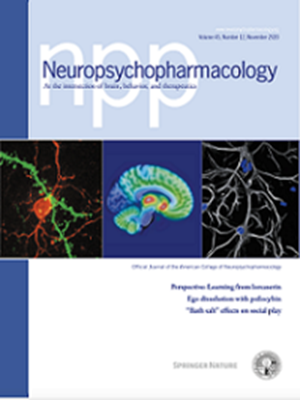创伤后应激障碍患者在回忆创伤记忆时的威胁神经回路表征解码。
IF 6.6
1区 医学
Q1 NEUROSCIENCES
引用次数: 0
摘要
创伤记忆回忆的神经回路机制仍不清楚。本研究调查了创伤记忆回忆是否涉及神经回路表征,这些表征是否反映了创伤后应激障碍(PTSD)患者在处理泛化威胁刺激时所涉及的活动模式。多变量模式分析用于训练 3 个解码器。在 73 名患有创伤后应激障碍的成年女性样本中,对 "创伤 "解码器进行了训练,训练内容是特异性创伤与中性叙述过程中的 fMRI 模式。另一批 125 名成年参与者完成了奖励和威胁学习任务,从中分别根据威胁或奖励结果传递过程中的神经模式训练了 "冲击 "和 "奖励损失 "解码器。这些解码器随后在不同的数据集上进行交叉测试,以便分析创伤记忆回忆在多大程度上涉及到与更普遍的厌恶刺激重叠的神经回路表征。解码器在四个与显著性处理相关的网络以及双侧杏仁核和海马面具中进行了训练和测试。在中扣带回/后脑岛网络中训练的电击解码器在创伤记忆回忆与中性记忆回忆中对电击的预测都有所提高。同样,创伤解码器在与显著性处理相关的多个网络中,对冲击与无冲击时的创伤回忆做出了更高的预测。奖赏损失解码器预测与创伤记忆回忆之间没有重叠,反之亦然。创伤后应激障碍参与者的再体验症状较重,他们在回忆创伤记忆时的冲击活动模式参与度最高。这些结果表明,创伤记忆回想所涉及的神经回路表征与威胁,特别是疼痛刺激的传递有重叠。本文章由计算机程序翻译,如有差异,请以英文原文为准。

Decoding threat neurocircuitry representations during traumatic memory recall in PTSD
The neurocircuitry mechanisms underlying recall of traumatic memories remain unclear. This study investigated whether traumatic memory recall engages neurocircuitry representations that mirror activity patterns engaged during generalized threat stimulus processing in Post Traumatic Stress Disorder (PTSD). Multivariate pattern analysis was used to train 3 decoders. A “trauma” decoder was trained on fMRI patterns during idiographic trauma versus neutral narratives in a sample of 73 adult women with PTSD. A separate cohort of 125 adult participants completed a reward and threat learning task, from which “shock” and “reward loss” decoders were trained on neural patterns during threat or reward outcome delivery, respectively. These decoders were then cross-tested on the alternative datasets, allowing analyses of the degree to which traumatic memory recall engaged neurocircuitry representations that overlap with more general aversive stimuli. Decoders were trained and tested in four networks related to salience processing as well bilateral amygdala and hippocampal masks. The shock decoder trained in a midcingulate / posterior insula network demonstrated elevated predictions for shock during traumatic versus neutral memory recall. Similarly, the trauma decoder made elevated predictions about trauma recall during shock versus no shock delivery across multiple networks related to salience processing. There was no overlap between reward loss decoder predictions and trauma memory recall or vice versa. PTSD participants with elevated re-experiencing symptoms demonstrated the highest engagement of shock activity patterns during trauma memory recall. These results suggest that trauma memory recall engages neurocircuitry representations that overlap with threat, specifically painful, stimulus delivery.
求助全文
通过发布文献求助,成功后即可免费获取论文全文。
去求助
来源期刊

Neuropsychopharmacology
医学-精神病学
CiteScore
15.00
自引率
2.60%
发文量
240
审稿时长
2 months
期刊介绍:
Neuropsychopharmacology is a reputable international scientific journal that serves as the official publication of the American College of Neuropsychopharmacology (ACNP). The journal's primary focus is on research that enhances our knowledge of the brain and behavior, with a particular emphasis on the molecular, cellular, physiological, and psychological aspects of substances that affect the central nervous system (CNS). It also aims to identify new molecular targets for the development of future drugs.
The journal prioritizes original research reports, but it also welcomes mini-reviews and perspectives, which are often solicited by the editorial office. These types of articles provide valuable insights and syntheses of current research trends and future directions in the field of neuroscience and pharmacology.
 求助内容:
求助内容: 应助结果提醒方式:
应助结果提醒方式:


